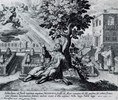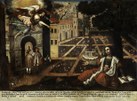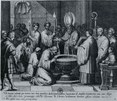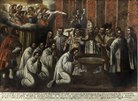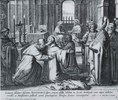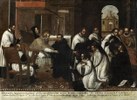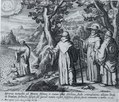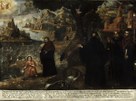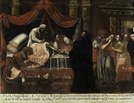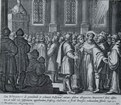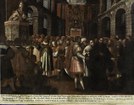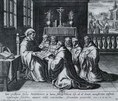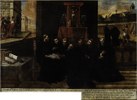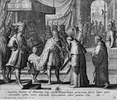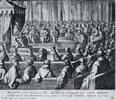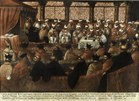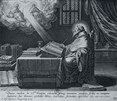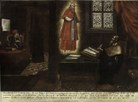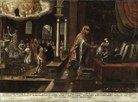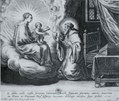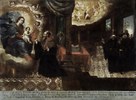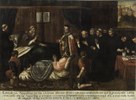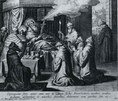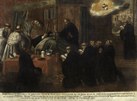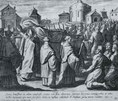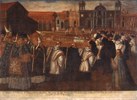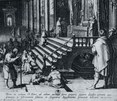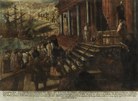Gallery 3:
Bolswert in Lima: The Series on the Life of Saint Augustine by Basilio Pacheco

Basilio Pacheco and his workshop: The Burial of Saint Augustine, ca. 1745. Convent
of Saint Augustine, Lima, Peru.
Schelte à Bolswert and Cornelis Galle produced a series of engravings on the Life of Saint Augustine which served as models for a set of paintings by Miguel de Santiago (see Gallery 2). But they also served as the basis for another group of paintings on the life of the saint. This was the series produced by Basilio Pacheco and his workshop between 1742 and 1746 (Vargas 195, 142; Courcelle and Courcelle 1972, Volume III, Chapter VII; Mesa and Gisbert 1982, I, 202f). It should be borne in mind, though, that neither the series of Miguel de Santiago nor the one by Basilio Pacheco could have relied exclusively on the series by Bolswert and Galle, as the latter did not consist of enough engravings.
It is generally believed that the series produced under the direction of Pacheco was originally intended for the Augustinian convent in Cuzco, but had to be moved to its counterpart in Lima after 1835, when the convent in Cuzco was demolished following a crushing earthquake (Wethey 1949, 298; Mesa and Gisbert 1962, 149; Courcelle and Courcelle 1972, Volume III, 101). But the paintings fit exactly into the spaces in the Lima cloister, thus suggesting that Lima could have been the original location (see MacCormack 2010).
Perhaps the most original painting in the series by Pacheco is the last one, which shows a self-portrait of Basilio Pacheco kneeling at the funereal procession of Saint Augustine—-a procession that led the remains of the saint, not to the Cathedral of Hippo, as history has recorded, but to the Cathedral of Cuzco instead (see figure above). As Mesa and Gisbert (1982, I, 202f) would have it, this painting is one of the masterpieces of the Cuzco school of painting. And the series as a whole is one that presents us with a painter who has reached the apex of his creative powers, has mastered draftsmanship and technique, and does not flinch at the large number of canvases he had to produce.
We have collected in this gallery the correspondences between the Bolswert-Galle series and the set of paintings by Basilio Pacheco. PESSCA wishes to thank Brunella Scavia and Daniel Giannoni for providing us with the images of the paintings of this gallery. At the time of first writing, the paintings had been recently restored and remained in storage at the Convent in Lima.

